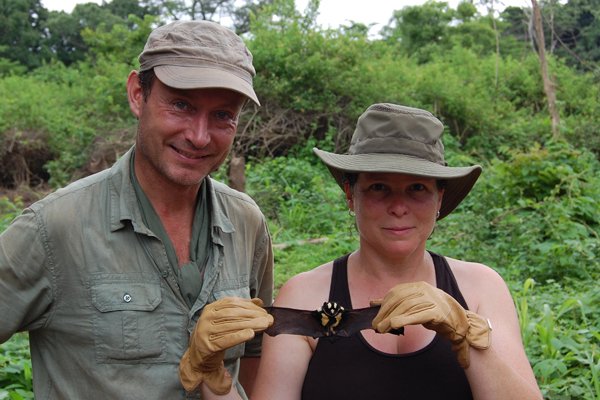Bats make up a quarter of the mammalian diversity on the planet, and they are the only mammal that can fly. The African continent and Madagascar and its associated islands contain about 258 extant species of bats, which comprises about 25% of the global bat diversity. Bats are an important component in ecosystem health and condition. They occupy a critical niche, the insectivorous species being primary nocturnal predators and are susceptible to increased levels of pesticides, while frugivorous species are critical for forest regeneration. Many plants are dependent on these night time visitors (e.g. Baobab), for both pollination and seed dispersal.
Researchers have identified a new genus of bat after discovering a rare specimen in South Sudan. With wildlife personnel under the South Sudanese Ministry of Wildlife Conservation and Tourism, Bucknell Associate Professor of Biology DeeAnn Reeder and Fauna & Flora International (FFI) Programme Officer Adrian Garside were leading a team conducting field research and pursuing conservation efforts when Reeder spotted the animal in Bangangai Game Reserve.

“My attention was immediately drawn to the bat’s strikingly beautiful and distinct pattern of spots and stripes. It was clearly a very extraordinary animal, one that I had never seen before,” recalled Reeder. “I knew the second I saw it that it was the find of a lifetime.”

“After careful analysis, it is clear that it doesn’t belong in the genus that it’s in right now,” Reeder said. “Its cranial characters, its wing characters, its size, the ears — literally everything you look at doesn’t fit. It’s so unique that we need to create a new genus.”

“Our discovery of this new genus of bat is an indicator of how diverse the area is and how much work remains,” Reeder added. “Understanding and conserving biodiversity is critical in many ways. Knowing what species are present in an area allows for better management. When species are lost, ecosystem-level changes ensue. I’m convinced this area is one in which we need to continue to work.”
Niumbaha superba is an insectivorous bat meaning it feeds primarily on just insects, insectivorous bats are critically important to the environment as they help keep pests in control that would otherwise if not controlled damage vast swathes of crops, trees, plants and invade human populated areas. Insectivorous bats are also very important to humans as they help keep mosquitoes in check that endanger human life by the spread of Malaria which is known to be one of the Africa’s largest human killing viruses in.
References
- https://deeannreeder.scholar.bucknell.edu/
- https://zookeys.pensoft.net/articles.php?id=3866
- https://beautifulnow.is/discover/nature-science/niumbaha-superba-a-beautiful-bat
- https://speakupforthevoiceless.org/2014/11/12/sudanese-badger-bat-niumbaha-superba/
- https://novataxa.blogspot.com/2013/04/niumbaha-superba.html?m=1
- https://en.wikipedia.org/wiki/Pied_bat
- http://www.dailymail.co.uk/sciencetech/article-2306798/The-lifetime-Bizarre-striped-Panda-bat-South-Sudan.html
- https://www.huffingtonpost.com/2013/04/10/panda-bat-new-genus-discovered-south-sudan_n_3054325.html
I hope you liked it, and that it will be useful, thank you for your time, do not forget to comment and, if you liked, vote and follow me for more material like this. @profesora
Hi! I am a robot. I just upvoted you! I found similar content that readers might be interested in:
https://www.sciencedaily.com/releases/2013/04/130409111603.htm
Downvoting a post can decrease pending rewards and make it less visible. Common reasons:
Submit